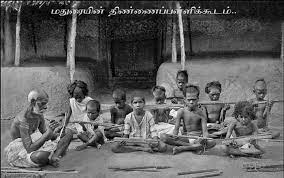Bhāratīya Education (Part – 4)

The Bhāratīya Elementary Education System
In Part-2 of this series was a brief sketch of the education that was imparted in India prior to the British system. From available records made by the British and also by other foreign travellers, we gather more details to get a clearer picture.
Education was imparted in two distinct phases – Elementary Education and Professional Education. In this part, Elementary Education will be described.
Overview
Firstly, there was no centralised education system in any region. The education of students was catered to as per the needs of the region and was in the local language and dialect. Secondly, despite the wide variations, the core content of elementary education across the nation revolved around character building and dharma. Third, children all over the nation – in Malabar and Madras, in Punjab, in Bihar and Bengal, or in Gujarat – were taught to read, write and do the basic arithmetic operations. Fourth, teachers were held in high regard across the nation and to support the teacher was the obligation of the community. Fifth, all over the country, the teachers were noted for being remarkably poor for the amount of service that they rendered.
School infrastructure and Teacher salaries
G. W. Lietner, in his book, ‘History of Indigenous Education in the Panjab,’ says that despite being torn by invasion and civil war, Punjab preserved and added to educational endowments, that even the individuals who were by far the worst in the society vied with one another to redeem their faults by founding schools and rewarding the learned. Not a temple, a mosque or a dharmasala was without a school attached to it to teach religion. Apart from these, thousands of secular schools in the villages that were frequented alike by Hindus, Muhammadans and Sikhs.
In the Southern states, the raised platform (Tiṇṇai) in front of the house was a standard architectural feature. The platform serves many purposes and, at the village teacher’s house, this was the school and was called Tiṇṇai Paḷḷikkūḍam (platform school). Despite the introduction of the British system, these survived until the early 20th century. The teachers were known as Andaṇars or Vaḷḷuvars and came from a multitude of communities and were not restricted to Brahmins.
Dharampal’s works show that it was common for teachers to sit under trees or under a thatched shelter to teach the students. It was also common for teachers to teach affluent students or girl students in the students’ homes.
Those who established schools also created endowments to yield income to run the schools. Each villager took pride in devoting a portion of their produce to a respected teacher.
Older students who were too poor to pay the teacher took to begging for alms from the villagers to feed themselves and the teacher. A Tamil song seeking oil for cooking was sung by the students in Sri Lankan villages – this song is still remembered.
These were in stark contrast to the British education system which emphasised on massive infrastructure for schools and career teachers who were paid fixed salaries.
Inclusivity of Schools
As per the records made by the British, children from all communities attended the village schools, the exception being those who were kept out from the society as ‘untouchables’ who were renamed ‘Harijans’ by Gandhi. The community-wise ratio of the children reflected the population ratio. Thus, there were more Śūdra children (skilled professionals) than the Brahmin (academics and priests) and the Vaiśya (businessmen) communities.
Schools mostly catered only to boys while girls had their education at home from their parents or from private tutors. There were a few schools in some pockets of the nation that had girl students also.
Curriculum
Since the centres for elementary education were places to reinforce culture – they were “watering holes of Culture” in Dharampal’s words – children were taught respect for elders, to know the roles to be played by each individual and each community to the society, to respect nature and to know one’s place in the bigger scheme of the society and in creation. The children of the Tamizh regions recited Āticūḍi and inculcated these as virtues to live by.
Studying the Rāmāyaṇa, the Mahābhārata and the Purāṇa(s) as per the tradition of the dominant community was part of elementary education. These were told and retold even via the informal education channels that included the performing and fine arts across all communities.
They were taught the contents of the dharmaśāstras in the local languages. Tirukkuraḷ which is taught in Tamil is a rendering of the dharmaśāstras in a cryptic form.
Thousands of students were acquainted with reading, writing and some form of computation. Tax math was taught. They wrote in Lunde which was a script with less flourish and no vowels.
Pedagogies used
Educating the masses was a method prevalent all over India when the British arrived. In fact, the advent of the Western Industrial Revolution saw a steep demand for education and the British took back many an idea from India to England and from there to the rest of the West.
Schooling Age Children began schooling between the ages of 5 and 8 – this was based on the child’s development and was not rigid. They usually completed Elementary Education between the ages of 12 and 14.
School duration School hours were long and began at sunrise and went on until sunset. All festival days were school holidays as the schools followed the traditional Indian calendar.
Memorising Rote learning and memorising were emphasised upon especially in the lower levels. The Monitor System was especially useful to facilitate memorising.
Writing Every child going to school learnt to write. A Scotsman named Dr Andrew Bell noticed this in Malabar where every child was taught to write (on sand) even before it was taught to read. Writing was a common part of the social transactions. Writing was, for the most part, on sand. Ink on plantain leaves was used until the student was trained to write well before expensive resources were used.
This was in contrast to the practice prevalent in contemporary Europe where children were taught to read while writing was kept aside as an activity for experts.
Zone of Proximal Development A Portuguese traveller named Pietro Della Valle wrote a journal about his experiences in India which was published in 1623. In his journal, he narrates how he watched four Indian children learning. They were repeating their lessons (he takes the example of multiplication tables) which the first student began singing as he wrote on sand spread in front of them and it was repeated by each child in sequence until it came to the first child who then sang the next line. Thus they learnt the lesson as they learnt to read and write at the same time. When he asked the children if they wouldn’t be making mistakes, they honestly repeated that if one makes a mistake someone else in the group would rectify it. This they repeated until the time allotted for them by their master.
He expresses his astonishment at how the learning happens to good memory even in the absence of the master and in such an economical manner. Towards the end of the 18th century (1700s), this method was again observed by Dr Bell in Madras. The same was implemented in British schools by Joseph Lancaster and this came to be known as the Bell-Lancaster Method or the Madras System or the Monitorial System of Education which helped in educating a large number of British children with a limited number of trained teachers. It is well documented in the Annual Review and History of Literature for 1805 that Lancaster borrowed it from India to be implemented in England (even as it was being phased out in India). The borrowers never acknowledged the source while crediting Bell and Lancaster. Bell even claimed to have had the ‘Eureka’ moment and that he followed the example of a Newton, a Franklin, a Lavoisier in his book, The Madras School’. A. D. Campbell, the Collector of Bellary, in 1823, noted that “the economy with which children are taught to write in the native schools, and the system by which the more advanced scholars are caused to teach the less advanced and at the same time to confirm their own knowledge is certainly admirable, and well deserved the imitation it has received in England.”
[In the early 20th century, a Russian psychologist named Lev Vygotsky made detailed studies on this method of learning and discovered that creating a scaffolding between students promoted efficient peer learning which he called Zone of Proximal Development (ZPD)].
Graduation levels Students did not have any fixed age-based graduation between classes or grades. There were variably 3 or 4 levels into which children were allotted based on their abilities. The student was deemed to have obtained Elementary Education at the discretion of the teacher based on personal observation.
Discipline Teachers were very strict disciplinarians when it came to punctuality, behaviour and mental alertness of the students. While corporal punishments were used by some teachers - caning, kneeling down or standing with arms raised above have been recorded as being used – while the others have been described as ‘non-violent’.
Thus, the objective of Elementary Education was clearly to prepare students to face life and society. They were moulded into individuals with good values, know their role in society and the life-skills to survive as productive and intelligent social beings. Humility was built to such an extent that self-centred ego building was looked down upon in the society. Social cohesiveness was ensured in such an education system. This phase of education served to nourish the students physically, emotionally, socially as well as intellectually. We can see that education took place effectively, with high economy and with the use of pedagogy that worked well and made sense for the masses.
Did all the children who were given Elementary education go to study further at academies? How were Higher education and Scientific Development faring in our country at that time?
(Will continue in the next part)
References:
Grey Edward ed. (1892). The Travels of Pietro Della Valle in India 1623 (Vol II), Hakluyt Society 1792. Available at https://www.rarebooksocietyofindia.org/book_archive/196174216674_10151529149931675.pdf
G. W. Lietner (1882). History of Indigenous Education in the Panjab, Superintendent of Govt. Printing. Available at http://www.panjabdigilib.org/webuser/searches/displayPage.jsp?ID=6767&page=1&CategoryID=1&Searched=
Dharampal (2000). The Beautiful Tree, Other India Press. Available at http://www.arvindguptatoys.com/arvindgupta/beautifultree.pdf
Vaman N (2015). Mattakalappil Hindukalvi parambariyam. Available at http://arayampathy.lk/research/36-09022016
Dr Nagaswamy R (2018). Thirukural - An Abridgement of Sastras, Giri Trading Agency.
Dede Chris, Richards John, Saxberg Bror (2019).Learning Engineering for Online Education Theoretical Contexts and Design-Based Examples, Routledge. Excerpt available at https://bit.ly/3gXbIIC
Tschurenev, Jana (2019). Empire, Civil Society, and the Beginnings of Colonial Education in India, Cambridge University Press.Excerpt available at https://bit.ly/2UcVP6K

